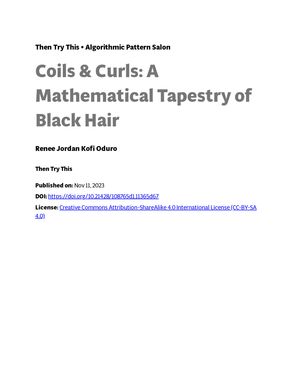TLDR Black hair's diversity in patterns and textures is influenced by follicle shape and keratin, and it holds cultural, artistic, and mathematical significance.
The document discusses the diverse range of patterns and textures inherent in black hair, which is determined by the shape of the hair follicle and the bonding of amino acids in the protein keratin. The paper explores black hair from various perspectives, including its roots, historical significance, societal perceptions, and its role as a form of style and expression. It approaches black hair as an art form, a mathematical pattern, an algorithmic growth process, and an ethnomathematical entity, aiming to dispel myths and highlight the myriad of possibilities that black hair represents.
53 citations
,
July 2016 in “Cosmetics” Future hair cosmetics will be safer and more effective.
 10 citations
,
January 2014 in “Genetics and Molecular Research”
10 citations
,
January 2014 in “Genetics and Molecular Research” Liaoning Cashmere goat hair follicles show synchronized growth patterns with lowest activity in May.
50 citations
,
July 2008 in “British Journal of Dermatology” 138 citations
,
March 2007 in “Experimental cell research” Only a few hair-specific keratins are linked to inherited hair disorders.
276 citations
,
January 2005 in “International review of cytology” More research is needed to understand how hair keratins work and their role in hair disorders.
 199 citations
,
January 2004 in “The International Journal of Developmental Biology”
199 citations
,
January 2004 in “The International Journal of Developmental Biology” Hair follicle growth and development are controlled by specific genes and molecular signals.
29 citations
,
April 2003 in “Experimental dermatology” Human hair follicles grown in vitro maintain normal keratin patterns and structure.
175 citations
,
January 1995 in “Birkhäuser Basel eBooks” Human hair growth and structure are influenced by keratin proteins, genes, melanin, and lipids.
 3 citations
,
April 1990 in “Archives of dermatology”
3 citations
,
April 1990 in “Archives of dermatology” The book reveals diverse patterns of hair growth in different species and advancements in hair and alopecia research.



